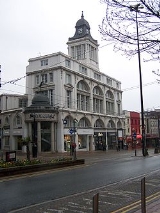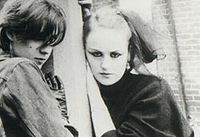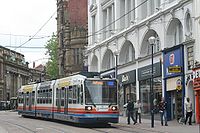
Crazy Daisy Nightclub
Encyclopedia
The Crazy Daisy Nightclub was a discotheque/dance club in Sheffield
, South Yorkshire
, England
in the late 1970s to late 1980s. Located originally on the Corner of York Street and High Street, Sheffield S1 1PU. It was known as The Beer Keller in the early to mid 1970s. In 1978 it was taken over by the Tetley company and became The Crazy Daisy. Situated in the basement of an art deco
building it featured numerous supporting pillars and a steep, sweeping staircase down from the entrance which was infamous for being responsible for many alcohol related trip accidents.
The Crazy Daisy club was in business from 1976 to the late 1980s. At the time it became synonymous with the avant-garde
early 1980s music scene. During its tenure it was a central social focal point in Sheffield city centre and claims a key role in 1980s Sheffield culture and British pop music history.
It later became Legends Nightclub and subsequently closed in the mid 1990s when the Sheffield social scene shifted to the redeveloped West Street area. The building is now used as a bank and shops, next to a Sheffield Supertram stop.
 The club is principally known in UK/US pop history and worldwide as the 'birth place' of the 'Mark Two' (commercially successful) version of the pop group The Human League
The club is principally known in UK/US pop history and worldwide as the 'birth place' of the 'Mark Two' (commercially successful) version of the pop group The Human League
.
Where, in October 1980 during a visit to the Crazy Daisy. Almost as an allegory of the Cinderella
story, Philip Oakey
(lead singer of the group), randomly spotted and recruited two totally unknown school girls, Joanne Catherall
and Susan Ann Sulley, into the group after the original members had walked out on the eve of an international tour. With no auditions or rehearsals, Sulley and Catherall were taken out of school to go on the tour with just 4 days' notice. The new group line up then rose rapidly to international prominence and enormous commercial success in the early and mid 1980s making internationally famous popstars of both girls.
The Human League continues recording and touring internationally to this day, 30 years later, still complete with Sulley and Catherall now in their mid-forties.
who recalls his nights in the club during an interview for Exposed magazine in January 2007.
 The last nightclub to occupy the building was Legends, this closed in the mid-1990s and because the night time social scene had since moved on, the site was redeveloped into commercial units. Since its redevelopment an outlet of Blacks outdoor pursuits store is now where the main entrance once stood and the bank Santander
The last nightclub to occupy the building was Legends, this closed in the mid-1990s and because the night time social scene had since moved on, the site was redeveloped into commercial units. Since its redevelopment an outlet of Blacks outdoor pursuits store is now where the main entrance once stood and the bank Santander
dominates the main building. Today there is no indication of the building's heritage or history. Because of its history the site is mentioned on a number of Sheffield tour guides, Sheffield city web sites and almost every Human League website/book.

Sheffield
Sheffield is a city and metropolitan borough of South Yorkshire, England. Its name derives from the River Sheaf, which runs through the city. Historically a part of the West Riding of Yorkshire, and with some of its southern suburbs annexed from Derbyshire, the city has grown from its largely...
, South Yorkshire
South Yorkshire
South Yorkshire is a metropolitan county in the Yorkshire and the Humber region of England. It has a population of 1.29 million. It consists of four metropolitan boroughs: Barnsley, Doncaster, Rotherham, and City of Sheffield...
, England
England
England is a country that is part of the United Kingdom. It shares land borders with Scotland to the north and Wales to the west; the Irish Sea is to the north west, the Celtic Sea to the south west, with the North Sea to the east and the English Channel to the south separating it from continental...
in the late 1970s to late 1980s. Located originally on the Corner of York Street and High Street, Sheffield S1 1PU. It was known as The Beer Keller in the early to mid 1970s. In 1978 it was taken over by the Tetley company and became The Crazy Daisy. Situated in the basement of an art deco
Art Deco
Art deco , or deco, is an eclectic artistic and design style that began in Paris in the 1920s and flourished internationally throughout the 1930s, into the World War II era. The style influenced all areas of design, including architecture and interior design, industrial design, fashion and...
building it featured numerous supporting pillars and a steep, sweeping staircase down from the entrance which was infamous for being responsible for many alcohol related trip accidents.
The Crazy Daisy club was in business from 1976 to the late 1980s. At the time it became synonymous with the avant-garde
Avant-garde
Avant-garde means "advance guard" or "vanguard". The adjective form is used in English to refer to people or works that are experimental or innovative, particularly with respect to art, culture, and politics....
early 1980s music scene. During its tenure it was a central social focal point in Sheffield city centre and claims a key role in 1980s Sheffield culture and British pop music history.
It later became Legends Nightclub and subsequently closed in the mid 1990s when the Sheffield social scene shifted to the redeveloped West Street area. The building is now used as a bank and shops, next to a Sheffield Supertram stop.
The Human League story

The Human League
The Human League are an English electronic New Wave band formed in Sheffield in 1977. They achieved popularity after a key change in line-up in the early 1980s and have continued recording and performing with moderate commercial success throughout the 1980s up to the present day.The only constant...
.
Where, in October 1980 during a visit to the Crazy Daisy. Almost as an allegory of the Cinderella
Cinderella
"Cinderella; or, The Little Glass Slipper" is a folk tale embodying a myth-element of unjust oppression/triumphant reward. Thousands of variants are known throughout the world. The title character is a young woman living in unfortunate circumstances that are suddenly changed to remarkable fortune...
story, Philip Oakey
Philip Oakey
Philip Oakey is an English composer, singer, songwriter and producer.He is best known as the lead singer, frontman and co-founder of the famous English synthpop band The Human League. He has also had an extensive solo music career and collaborated with numerous other artists and producers...
(lead singer of the group), randomly spotted and recruited two totally unknown school girls, Joanne Catherall
Joanne Catherall
Joanne Catherall is an English singer; best known as one of the two female vocalists of the veteran English synthpop band The Human League.Born and raised in Sheffield, England...
and Susan Ann Sulley, into the group after the original members had walked out on the eve of an international tour. With no auditions or rehearsals, Sulley and Catherall were taken out of school to go on the tour with just 4 days' notice. The new group line up then rose rapidly to international prominence and enormous commercial success in the early and mid 1980s making internationally famous popstars of both girls.
The Human League continues recording and touring internationally to this day, 30 years later, still complete with Sulley and Catherall now in their mid-forties.
Other famous connections
Another regular patron of the Crazy Daisy in the early 1980s was stage and Hollywood film actor Sean BeanSean Bean
Shaun Mark "Sean" Bean is an English film and stage actor. Bean is best known for playing Boromir in The Lord of the Rings Trilogy and, previously, British Colonel Richard Sharpe in the ITV television series Sharpe...
who recalls his nights in the club during an interview for Exposed magazine in January 2007.
The building today

Santander UK
Santander UK plc is a wholly owned subsidiary of the Spanish Santander Group. Based in the United Kingdom, it operates under the name of Santander. Santander is the third largest bank in the UK in terms of deposits, the second largest in terms of mortgages held, and the fourth largest in terms of...
dominates the main building. Today there is no indication of the building's heritage or history. Because of its history the site is mentioned on a number of Sheffield tour guides, Sheffield city web sites and almost every Human League website/book.
In the media

- In 2004 for its association with The Human League, The Crazy Daisy was nominated as one of Britain’s top ‘Rock Landmarks’ in a feature program of the same name, although it did not eventually make the final top 10.
- In 2007 the VH1VH1VH1 or Vh1 is an American cable television network based in New York City. Launched on January 1, 1985 in the old space of Turner Broadcasting's short-lived Cable Music Channel, the original purpose of the channel was to build on the success of MTV by playing music videos, but targeting a slightly...
UK documentary The Nation's Music Cities – (Sheffield) (first broadcast on 26 May 2007) featured a prominent section on The Crazy Daisy. The documentary included an interview with Susan Ann Sulley and Joanne Catherall which was filmed outside Blacks (the former club entrance), where they discussed the building’s significance and its history in the 1980s.
- In 2008, artist Pete McKeePete McKeePete McKee is a painter and commercial artist from Sheffield, England. He is a cartoonist for the Sheffield Telegraph’s sports section. He has exhibited regularly around the north of England. Using bright colours his larger than life, often humorous characters inhabit a world of working men's...
produced a Pop ArtPop artPop art is an art movement that emerged in the mid 1950s in Britain and in the late 1950s in the United States. Pop art challenged tradition by asserting that an artist's use of the mass-produced visual commodities of popular culture is contiguous with the perspective of fine art...
painting entitled "The Night Phil Oakey met Susan and Joanne" which depicts Sulley and Catherall arriving at The Crazy Daisy on the night they were discovered in October 1980.

